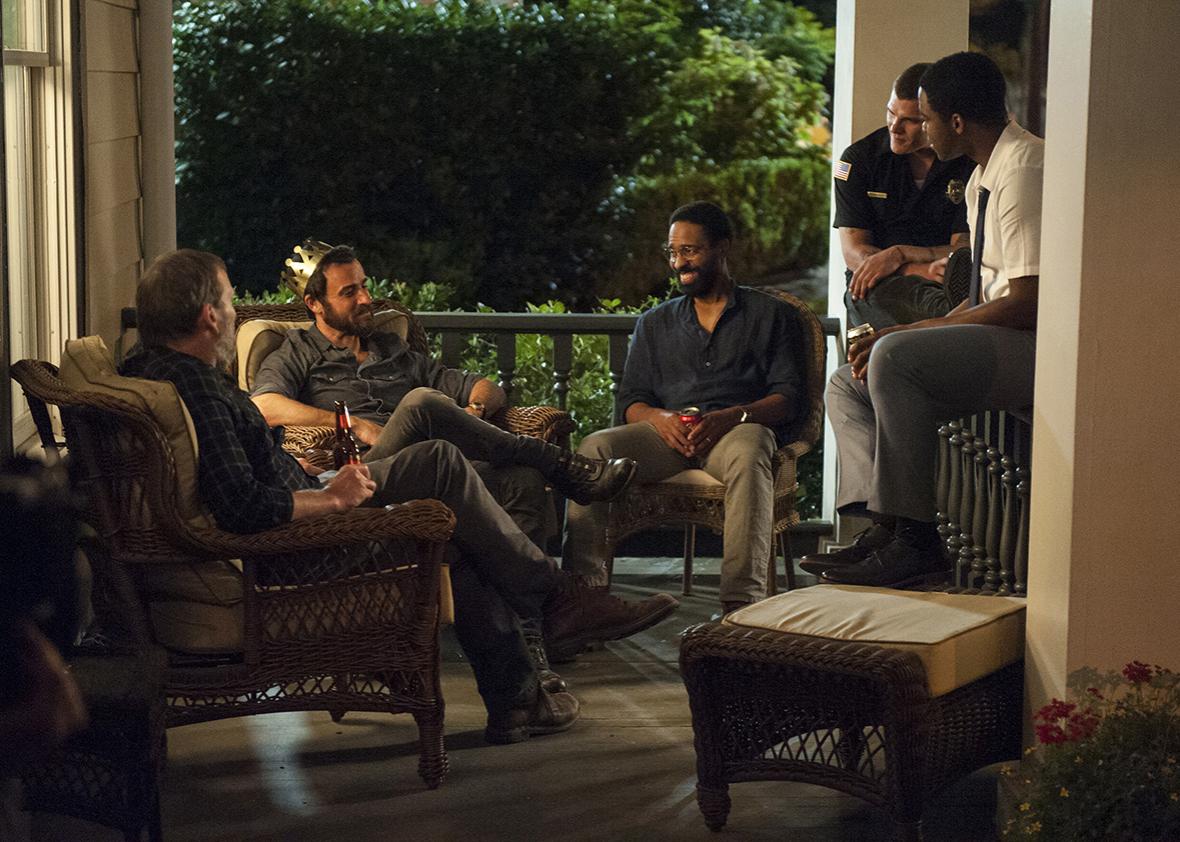The first season of Damon Lindelof’s The Leftovers, about a world in which 2 percent of the population has inexplicably vanished, was like the hair shirt of television shows: impressively willing to cause user discomfort, both of the physical and spiritual variety. The tremendous third and final season, in contrast, wears no shirt at all—and no pants either. The new season of The Leftovers, which premieres Sunday night on HBO, is swaggering and strange, unhinged and unpredictable, encompassing floods, sex parties, Perfect Strangers, nuclear bombs, bad tattoos, doppelgangers, didgeridoos, lion attacks, maybe-messiahs, suicide, grief, sadness, love, and hope as it zooms around a planet in the midst of an existential crisis. The show has entered full-blown mania as twisted, thrilling, and devastating to watch as a person speaking in tongues.
The Leftovers began three seasons ago in a capital of emotional anguish known as Mapleton, New York, a town maintaining an uneasy calm three years after the Sudden Departure. The seemingly workaday residents of Mapleton included Kevin Garvey (Justin Theroux), the tightly wound police chief about to begin having visions, his erstwhile wife Laurie (Amy Brenneman), caught up in a cult, and their children, as well as Nora Durst (Carrie Coon), whose entire family departed, and her brother Matt (Chris Eccleston), a preacher convinced the departure was not the rapture. Life in Mapleton appeared to be continuing more or less normally, but the questions raised by the Departure (What was it? Was it holy or mundane? Was it better to have survived or left?) had shredded its residents emotionally. The subsequent wreckage was singular, special, and not unlike getting into a scalding bath one’s body never adjusts to. It hurt, perhaps too much for a leisure activity.
The second season immediately announced itself as something stranger and more ambitious, beginning with a long sequence set in the prehistoric past in which a pregnant woman tried (and failed) to survive the death of her entire clan in an earthquake, a departure of its own. In the present, Mapleton had been abandoned for the town of Jarden, also known as Miracle, Texas, which had lost none of its 9000-plus residents in the departure and thus become a kind of holy site. The now becoupled Kevin and Nora decamped to start a new life there and quickly became entangled with next-door neighbors John (Kevin Carroll) and Erica Murphy (Regina King), whose daughter Evie (Jasmin Savoy Brown) soon went missing. The scope of The Leftovers expanded to make room not only for the Murphys, their children, and the chaos of Miracle—with pilgrims banging down its doors and men sacrificing goats in local restaurants—but Kevin’s increasingly involved visions/hallucinations.
In the third season, the canvas of The Leftovers has expanded further still. It is still concerned with all the themes of the first season—grief, loss, survival—while feeling almost nothing like it. Claustrophobic emotional repression has given way to gonzo and grandiose pain, stretched all over the world. No one is pretending things are normal anymore. The new season begins, after brief stopovers with an 1844 doomsday cult and a clandestine military operation, in Jarden three years after the second season ended. Life seems … good. The Garveys, the Dursts, and the Murphys, slightly reconfigured in arresting ways, gather for a birthday celebration. Laughter is abundant. The horrors of the world seem at a safe distance. All, of course, is not what it seems. Small details—a cast on Nora’s arm, a loving shot of a baby, a secret writing project, the looming seventh anniversary of the Departure—soon reveal themselves to be harbingers of pain and chaos.
The Leftovers begins jetting from character to character, from Texas to Missouri, Melbourne, Tasmania, the Outback, and the feverish wilds of Kevin’s mind. The new season feels like a magic trick: How is it all hanging together? Unlike the first two seasons, it at least has a propulsive narrative engine: the looming end of days. The seventh anniversary is a particularly potent one, and people the world over are convinced the apocalypse is imminent. Men at the airport are trying to get to Antarctica; others believe themselves to be God; others still think a seven-headed monster predicted in Revelations is about to launch a nuke; and then there are our protagonists, around half of whom have come to believe that Kevin Garvey is the second coming.
The Leftovers initially seemed to be about regular people (if ones, like Justin Theroux, with an unsettlingly small amount of body fat), but Kevin is not regular even if, perhaps, he is not the Messiah. Last season, to rid himself of crippling visions, Kevin drank poison and died, only to be revived—not his only close brush with death. Matt, John, John’s son Michael (Jovan Adepo), and Kevin’s father (Scott Glenn) are all convinced that Kevin is holy and will be instrumental in saving the world from whatever is going to happen on the seventh anniversary, and they are willing to act on those convictions. One of the more intriguing moves the new season makes is to have the protagonists with outlandish beliefs encounter other true believers and determine over and over again that they are nutjobs. Strange convictions only seem crazy when they belong to someone else.
As gonzo as the new season is, it never loses touch with what the show is about: coping with unbearable loss. Suicide is everywhere. Even seven years later, almost every character wakes up each morning and makes an active determination to go on—or not. As the world sprints toward its maybe end, the characters themselves become amped up, manic, and high-energy, forced to face the awful, looming question: Can they survive with this much pain? Maybe the craziest act of faith is to simply to keep on living.
